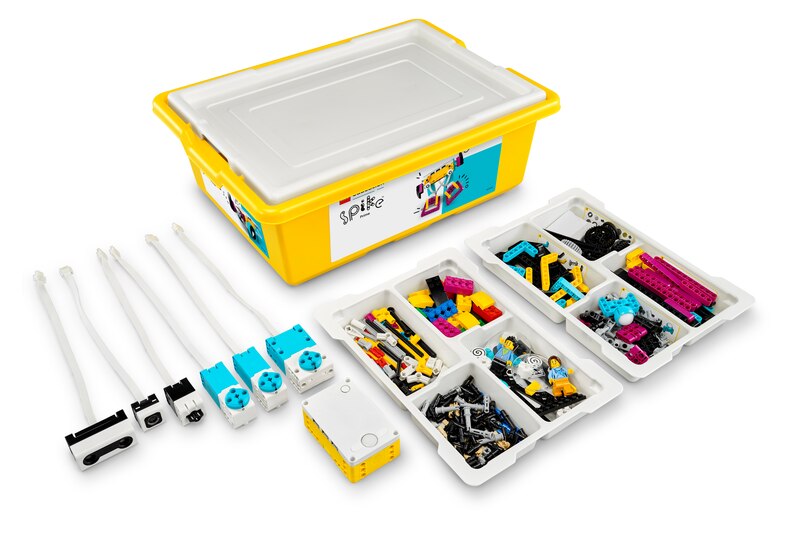Waste management is crucial for our environment’s well-being. Every individual’s effort matters in reversing its harmful effects. Responsible waste handling can have a significant impact on our surroundings. Small steps, like cleaning up garbage dumped in our neighborhood and disposing of trash properly, can make a difference.
Environmental studies in the school curriculum play a crucial role in instilling a sense of moral responsibility and accountability among young students. By learning about the environment, its importance, and the impact of human actions, children develop a deeper understanding of their role in preserving and protecting the planet.
LEGO® Education SPIKE™ Prime
Super Cleanup Children are the change-makers of tomorrow, and it is essential to empower them with the necessary skills and mindset to tackle our world’s challenges. LEGO® Education, therefore, provides a platform to schools by which hands-on learning experiences can be combined with the power of play to motivate students to be inventors of the future and find real-world solutions to problems.
The SPIKE™ Prime Super Cleanup lesson plan offers a valuable opportunity to not only initiate a discussion among students about proper waste handling but also raise awareness about the significant contributions of our hardworking sanitary workers. They can learn about the importance of responsible waste handling, the impact of improper disposal, and the need for recycling and composting.
By working with the SPIKE™ Prime robotics platform, students can actively participate in designing and creating solutions for waste management challenges, such as the grabbers and controllers.
Lesson Plan:
Preparatory Phase: Student material is available as a part of the LEGO® Education SPIKE™ App to describe the project’s objective. Teachers must encourage students to review the same before initiating the activity.
Topic Discussion: Start a discussion in class to test their knowledge about the various equipment and machines used in the waste collection process. The conversation can include questions such as;
- Why do people use grabbers to pick up litter?
- How would you know which grabber is the best?
- Have you ever done online research to check the product review?
Ask students to watch a video about a grabber and explain the benefits of the same. For better understanding, elaborate on the following; a garbage grabber, also known as a litter picker or trash picker, is a handheld tool designed to pick up and collect waste or litter from the ground. It typically consists of two long arms connected at a hinge or pivot point, with a gripping mechanism at the end. The gripping tool usually involves claws or jaws that can be opened and closed by squeezing a handle or trigger.
Garbage grabbers are commonly used by sanitation workers, volunteers, or individuals who want to clean up littered areas without touching the waste directly. The tool allows for easy and hygienic collection of various types of garbage, such as plastic bottles, wrappers, cans, paper, and other debris.
Building the Grabber
To nurture a spirit of teamwork, the class can be divided into teams, enabling students to work collaboratively, take on leadership roles, and engage in effective brainstorming sessions. Ensure each participant within the team is actively contributing towards building the Grabber machine using LEGO® Education SPIKE™ Prime set for proper hands-on learning.
- Student A: Grabber 1
- Student B: Grabber 2 and Controller
Design & Code Different Types of Grabbers
- Grabber 1 will essentially be useful for picking up light garbage and objects that are easily moldable. It uses flexible claws to clamp the pieces of objects tightly without letting the pieces fly away.
- Grabber 2 has to be designed to grab large, heavy objects. Its split claw makes it appropriate to grip heavy-duty items and transfer them precisely in the garbage truck. For the experiment in class, heavy objects could include things like an apple, a stone, or a steel water bottle.
Use a Variety of Objects
The students now practice hands-on learning and are tasked with testing the functionality of their grabbers. To do so, they begin searching for objects within the classroom or their own homes. The aim is to gather items that vary in size and weight, enabling them to compare the performance of the two different grabbers. Light objects to include can be such as the following:
- LEGO Brick (small)
- A crumpled ball of paper (medium)
- Empty plastic bottle (large)
Medium-sized objects of different weights include:
- A crumpled ball of paper (light)
- Stack of LEGO wheels (medium)
- Apple (or any round fruit) (heavy)
Does the Grabber Function Properly?
It’s time to put the devices to the test. Begin by placing the objects individually on the table and attempting to grasp them with the grabber. Transfer each object to another table using the grabber. After completing each task, note your findings to evaluate the success of the grabber’s performance.
- Blue: Indicates the grabber is successfully functioning
- Yellow: Both the grabbers (A and B) are successfully tested
- Violet: Based on the test, the student make a decision about the best grabber design
In conclusion, the Super Cleanup module by LEGO® Education SPIKE™ Prime is an effective and engaging educational tool for students. Through hands-on learning, it teaches students about coding, robotics, coding, and problem-solving while promoting teamwork and creativity.

